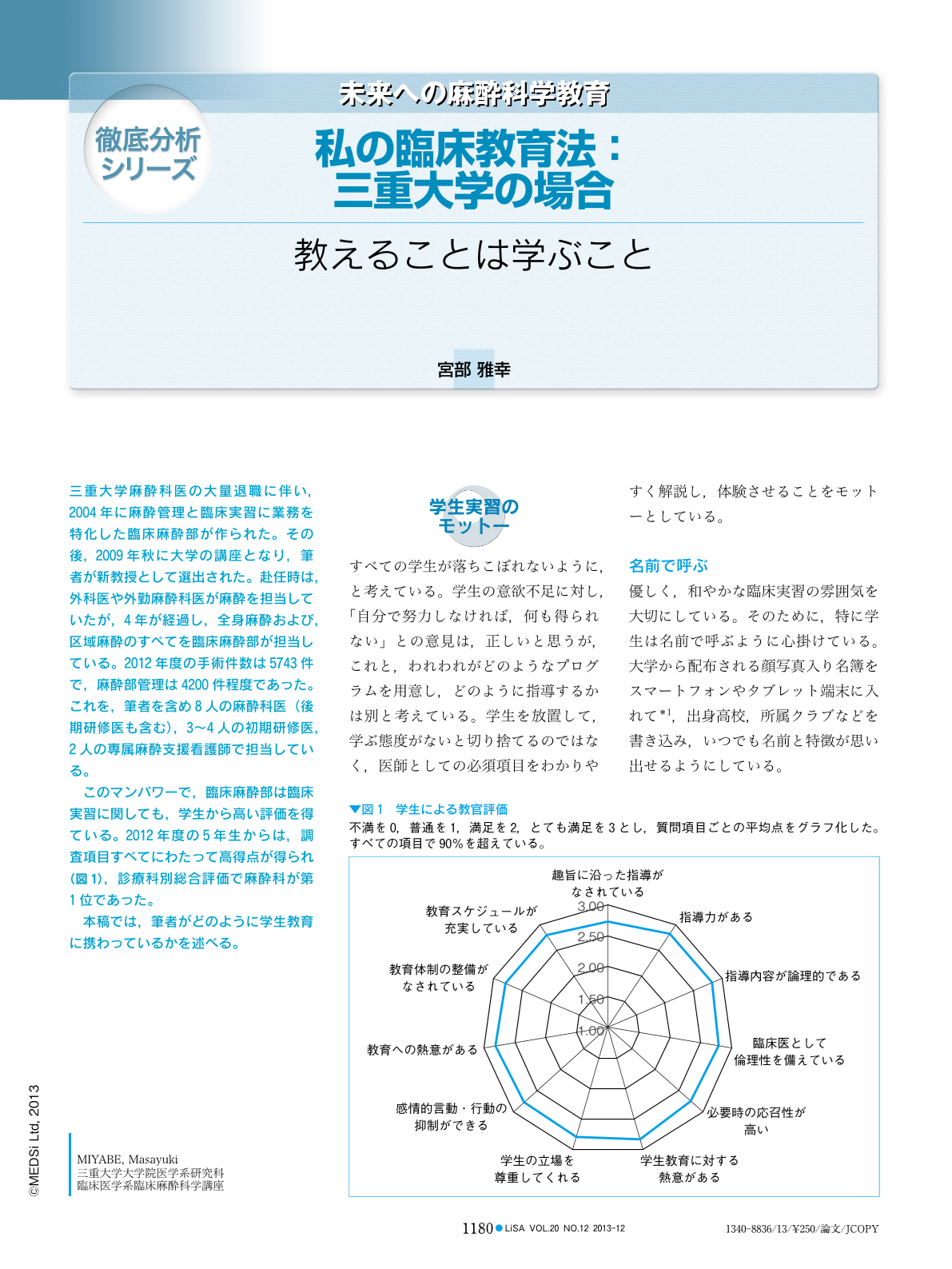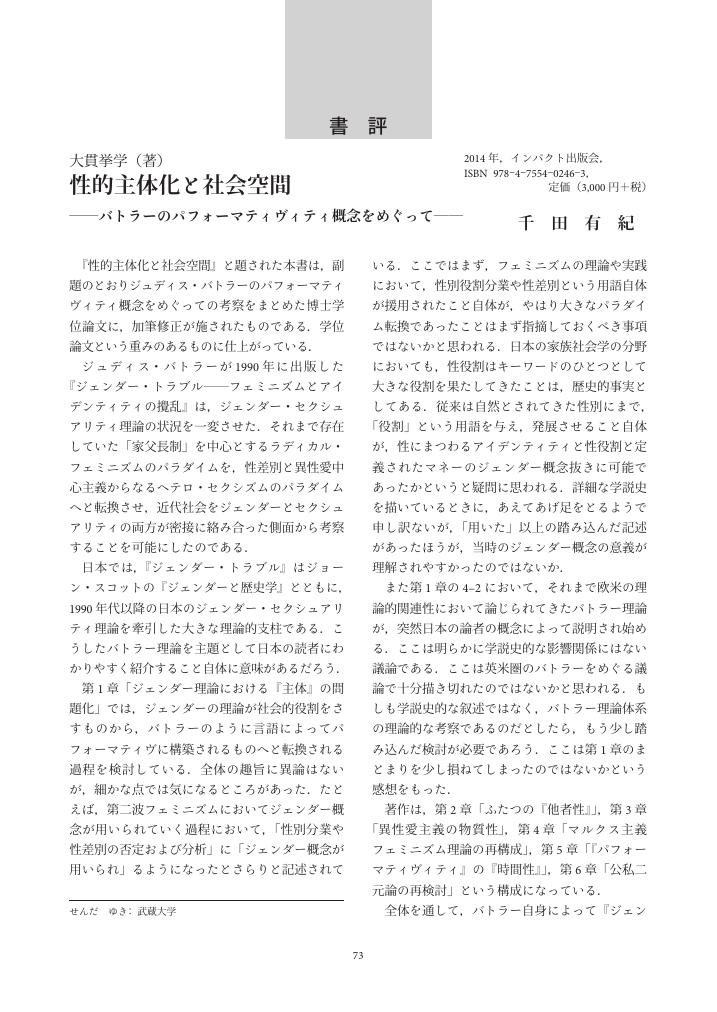- 著者
- 高橋 永行
- 出版者
- 山形県立米沢女子短期大学国語国文学会
- 雑誌
- 米沢国語国文 (ISSN:02876833)
- 巻号頁・発行日
- no.46, pp.202-191, 2017
1 0 0 0 道範の秘密念仏思想 -名号観を中心として-
- 著者
- 佐藤 もな
- 出版者
- 日本印度学仏教学会
- 雑誌
- 印度學佛教學研究 (ISSN:00194344)
- 巻号頁・発行日
- vol.49, no.2, pp.614-616, 2001
1 0 0 0 OA イランのザグロス山脈,シラーズ北方のボラギ盆地に発達する石灰岩中の注入構造
- 著者
- 伊藤 穂高 久田 健一郎
- 出版者
- 一般社団法人 日本地質学会
- 雑誌
- 地質学雑誌 (ISSN:00167630)
- 巻号頁・発行日
- vol.113, no.3, pp.V-VI, 2007-03-15 (Released:2013-03-23)
- 参考文献数
- 1
- 被引用文献数
- 1 1
1 0 0 0 OA チタン合金の加工と応用
- 著者
- 木村 啓造 田村 久義
- 出版者
- 一般社団法人 表面技術協会
- 雑誌
- 実務表面技術 (ISSN:03682358)
- 巻号頁・発行日
- vol.28, no.11, pp.551-555, 1981-11-01 (Released:2009-10-30)
1 0 0 0 西成高校の取組と課題:―西成高校での実践から―
- 著者
- 蔵戸 晋悟
- 出版者
- 関西教育行政学会
- 雑誌
- 教育行財政研究 (ISSN:0386393X)
- 巻号頁・発行日
- vol.41, pp.43-46, 2014
- 著者
- 平川 達
- 出版者
- 日本民族衛生学会
- 雑誌
- 民族衛生 (ISSN:03689395)
- 巻号頁・発行日
- vol.25, no.2, pp.126-132,A11, 1959
4. A survey of birth and birth-control; The average numberof birth of a woman was 3.5, which is not so high. The number of birth tended to decrease in younger generation. According to the survey on birth-control, among 48 ansewers of whom used to practice birth-control, the economical reason proved 27.1 %. Besides, it was remarkable that artificial abortion was popular
1 0 0 0 一島嶼 (伊豆七島利島) に於ける婚姻の調査研究:第5報近親結婚
- 著者
- 平川 達
- 出版者
- 日本民族衛生学会
- 雑誌
- 民族衛生 (ISSN:03689395)
- 巻号頁・発行日
- vol.25, no.2, pp.133-139,A11, 1959
5. Consanguineous marriage; The frequency of consanguineous marriage was 11.9 per cent, among which the marriage between consins were the most. The 1.62 per cent of the whole population were psychotic. This percentage is rather high comparing with other island of Izu. It was also noticed that there would be some consanguineous relations among these psychotics.<BR>Using Prof. Koike's classification, it was recognized that finger-prints were frequent in the type S and in the type OW in hand.
- 著者
- 木村 直也
- 出版者
- 校倉書房
- 雑誌
- 歴史評論 (ISSN:03868907)
- 巻号頁・発行日
- no.711, pp.27-36, 2009-07
- 著者
- 山田 勝治
- 出版者
- 不明
- 雑誌
- 日本教育社会学会大会発表要旨集録
- 巻号頁・発行日
- no.62, pp.426-427, 2010
- 著者
- 大谷 禎之介
- 出版者
- 法政大学経済学部学会
- 雑誌
- 経済志林 = The Hosei University Economic Review (ISSN:00229741)
- 巻号頁・発行日
- vol.73, no.1・2, pp.1-77, 2005-07-30
In Japanese translations of Marx' works, the word "assoziiert" (associated) in the attributive usage is interpreted sometimes in the passive sense. Such translations seem to have led to misunderstandings regarding Marx' notion of "association" as the unique form of our future society. Marx used the word "assoziiert" (associated) as an attributive participle solely in the active sense, whereas the word "kombiniert" (combined) was almost always used as an attributive participle in the passive sense. This means that "assoziierte Individuen" (associated individuals) are individuals who have actively and consciously joined themselves together as the subject, while "combined laborer" refers to the laborers as a whole, made up of individuals whose labor-power was purchased separately and who were then united into a single unit and put to use as a joint social power within a workshop or factory―either by a capitalist as the personification of capital or a joint-stock-company as associated capitalists. In this matter it is essential to recognize that there is a group of past participles that are not derived from transitive verbs. There are some reflexive verbs in German, some pronominal verbs in French, and also some intransitive verbs in English, whose past participles can qualify a noun attributively. However, not only in English, but also in German as well as in French, these participles cannot be distinguished, in terms of their external form, from transitive verbs, because their reflexive pronoun is dropped when they are used attributively. The attributive participle assoziiert in German, associé in French, and associated in English, which Marx used often in his works, are all fundamentally examples of such verbs. For instance, in the expression "associated individuals," the subject associating actively is each of the "individuals," not any external power. The core of Marx' idea of "association" as the future society is that "free laboring-individuals" make up this society by "associating" subjectively, consciously, and therefore actively. In this article I explain not only the distinctions and connections between laborers passively being "combined" by capital to form the "total laborer," and the active "associating" of individual producers to form an "association," while also discussing the natural course through which the former should precisely produce the latter. In an addendum, I investigate the meaning and context in which Marx and Engels used the word "Vergesellschaftung" (socialization) and "vergesellschaftet" (socialized) in their works. With this small study, which is chiefly limited to language-related matters, I have sought to further clarify Marx' idea "association" by eradicating possible misunderstanding related to the meaning of the attributive participle "associated."
1 0 0 0 私の臨床教育法:三重大学の場合―教えることは学ぶこと
- 著者
- 宮部 雅幸
- 出版者
- メディカル・サイエンス・インターナショナル
- 巻号頁・発行日
- pp.1180-1182, 2013-12-01
三重大学麻酔科医の大量退職に伴い, 2004年に麻酔管理と臨床実習に業務を特化した臨床麻酔部が作られた。その後, 2009年秋に大学の講座となり,筆者が新教授として選出された。赴任時は,外科医や外勤麻酔科医が麻酔を担当していたが,4年が経過し,全身麻酔および,区域麻酔のすべてを臨床麻酔部が担当している。2012年度の手術件数は5743件で,麻酔部管理は4200件程度であった。これを,筆者を含め8人の麻酔科医(後期研修医も含む),3~4人の初期研修医,2人の専属麻酔支援看護師で担当している。 このマンパワーで,臨床麻酔部は臨床実習に関しても,学生から高い評価を得ている。2012年度の5年生からは,調査項目すべてにわたって高得点が得られ(図1),診療科別総合評価で麻酔科が第1位であった。 本稿では,筆者がどのように学生教育に携わっているかを述べる。
1 0 0 0 OA 大貫挙学(著)性的主体化と社会空間――バトラーのパフォーマティヴィティ概念をめぐって――
- 著者
- 千田 有紀
- 出版者
- 日本家族社会学会
- 雑誌
- 家族社会学研究 (ISSN:0916328X)
- 巻号頁・発行日
- vol.28, no.1, pp.73-74, 2016-04-30 (Released:2017-08-26)
1 0 0 0 景観にさぐる中世 : 変貌する村の姿と荘園史研究
1 0 0 0 中国地方の荘園
- 著者
- 網野善彦 [ほか] 編
- 出版者
- 吉川弘文館
- 巻号頁・発行日
- 1999
1 0 0 0 日本姓氏大辞典
- 著者
- 丹羽基二 日本ユニバック著
- 出版者
- 角川書店
- 巻号頁・発行日
- 1985
1 0 0 0 全国国衆ガイド : 戦国の"地元の殿様"たち
1 0 0 0 鷺洲町史
- 著者
- [大阪府西成郡]鷺洲町史編纂委員会編
- 出版者
- 大阪府西成郡鷺洲町役場
- 巻号頁・発行日
- 1925








